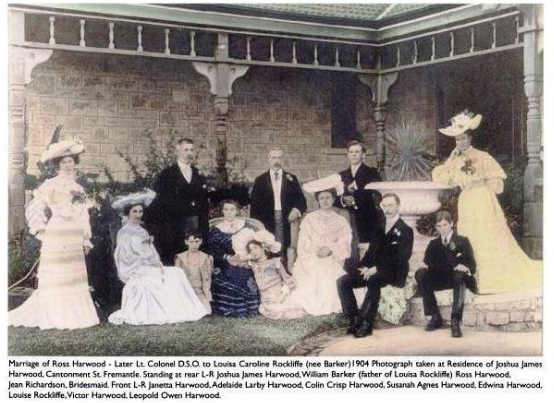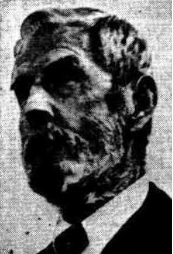J.J. harwood
(1849-1943)
Joshua James Harwood was born 18 October 1849 at Adelaide, South Australia. He became a well known architect and Chief Inspector of Public Works in Western Australia from 1884-1905.
His father Joshua Josiah Harwood Snr (1825-1897) arrived in Fremantle in 1842, from England and married Janetta (nee Tucknott) at Adelaide in 1846. They returned to Western Australia with Joshua junior in 1851.
By 1873 the couple had a further 10 children. Harwood senior was for many years a well-known figure in the business and commercial life of Fremantle. At the port town he established himself as a contractor and builder, and as a sideline engaged in the whaling industry. This whaling business though conducted by him on a small scale and confined to the coastal waters in the vicinity of the port in the 1850s was, relative to the capital and labour employed on it, a fairly lucrative one. The family owned Lots 73 and 74, 2 Henry St from 1858 - 1878. Joshua was also Publican of the Crown and Thistle Hotel ( now the Cleopatra Hotel) from 1868 - 1876 and had an office at 14 Mouat St from 1877 - 1879. J.J. Harwood senior eventually bankrupted in 1888 and the property in Henry Street burnt down the same year. Joshua Josiah Harwood Snr died in Fremantle in 1897.
Young Harwood, who had been educated privately, was at the age of 15 put to the building trade with his father but after partially qualifying to succeed him was attracted to the pearling industry in the North West. After two years there he rejoined his father and took up the study of architecture and engineering, preparatory to launching out on his own.
J.J. Harwood was responsible for the erection at Fremantle of a number of important business premises, including several large warehouses at the port, at that time the wholesale distributing centre for the colony. Harwood Jnr built the Fremantle Courthouse in 1883 for the Public Works Department.
He also designed and built a number of residential buildings, and was entrusted with the completion of St John's Church. This latter work seems to have attracted the special attention of James Thomas (1826-1884), then Commissioner of Public Works, who offered him the position of Chief Inspector of Public Works, which he accepted in 1884.
Harwood’s employment required that he should inspect, while under construction or repair, roads and bridges and public buildings, in short all public works save only the railways. The work involved almost continuous travelling all over the settled portions of the State from Wyndham to Albany. The post was held by Harwood until the coming of C.Y. O'Connor as Engineer in Chief, when a policy was adopted under which the public works inspectional duties were allotted to as many officers as there were sub-departments.
Harwood married Susannah Agnes Ougden (1854- 1942) at the Trinity Congregational Church, Perth in 1872. Of their eleven children, four died in childhood, and two sons were killed in the ‘Great War’.
In 1896 Harwood was PWD chief inspector at a salary of £450 p.a., and by 1905 PWD chief inspector maintenance at £475.
With a reorganisation of the PWD in early 1905, a number of senior architects including Harwood, A.R.L. Wright (district architect Coolgardie) and A.E Cox (district architect Geraldton) chose to enter private practice rather than apply for new government positions. In 1905 after 21 years' service Harwood was retired on a pension of £205. He then started in business on his own account.
In 1906 Harwood is listed in practice as an ‘architect, engineer, arbitrator and valuator’ at the National Mutual Buildings in St Georges Terrace, and he served as a councilor of the West Australian Institute of Architects from 1908 to 1910.
Harwood was primarily involved with small-scale projects in this second phase of his architectural career, commencing with the design of a Church of England rectory at East Perth. He practised for a few years with his son Ross, under the title of J.J. Harwood & Son, but is not listed in 1911-1912. From 1913-1922 Harwood was listed in Wises Directory at Subiaco, suggesting that he finally retired from practice in his early 70s.
Joshua James Harwood died 27 July 1943 at a nursing home in Mount Lawley, in his 94th year, and was buried in the Anglican section at Karrakatta Cemetery.
This biography of Joshua James Harwood, was written by Dr John J. Taylor November 2013
References:
'Public Works Department', The West Australian, 24 January 1905, p.6 (PWD reorganisation).
'Public Notice', The West Australian, 17 March 1905, p.3 (commences private practice).
‘Tenders’, The West Australian, 12 April 1905, p.5 (C.E. rectory Claisebrook Rd East Perth).
‘Tenders’, The West Australian, 19 June 1909, p.8 (residence Outram St West Perth).
‘Tenders’, The West Australian, 6 October 1911, p.3 (additions to Union Restaurant William and
James Sts Perth).
‘Tenders’, The West Australian, 5 September 1912, p.1 (residence Midland for Wesley Inkpen).
‘Tenders’, The West Australian, 14 September 1912, p.3 (residence Mount Lawley).
‘Tenders’, The West Australian, 4 November 1913, p.10 (reconstruction 3 warehouses Queen
Street Perth for D.W. Harwood).
‘Tenders’, The West Australian, 7 January 1914, p.3 (residence Tourist Rd near Albany).
'Whaling and Building', The West Australian, 21 October 1939, p.4 (background).
'An Old Colonist', The West Australian, 28 July 1943, p.2 (obituary).
HARWOOD Colin Crisp: NAA series B2455, Item barcode 4738514.
HARWOOD Victor Albert: NAA series B2455, Item barcode 4738549.
Harwood, James; Coe, John J., Life’s a Hoot, The Autobiography of James Harwood, 2004
accessed 3 Dec 2013 at www.books.google.com.au/, pp. viii, 1-3.
Citation details:
Taylor, Dr John J., ‘Joshua James Harwood (1849-1943)', Western Australian Architect
Biographies, http://www.architecture.com.au/ accessed DATE
Joshua James Harwood family photo at Fremantle, 1904 (Life's a Hoot, p.viii).



